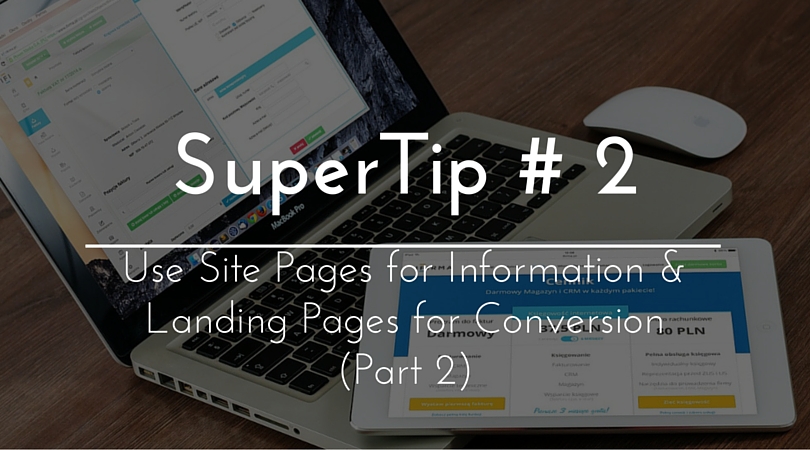
SuperTip #2 (Part 2/2)
Use Site Pages for Information & Landing Pages for Conversion
The Tactic
This article is continued from part 1
Your Landing Pages Are Your Invitations
I once decided to have a party at my home. I didn’t send out any invitations or let anyone know that I was having the party.
It wasn’t much fun because nobody showed up.
Absurd as that story might sound, it’s the way many business owners I talk to approach traffic to their website. They expect that by just telling people their (web) address, they’ll just “show up.”
Now, I don’t know about you, but other than a small group of friends and family, I don’t often have a ton of people just randomly “drop by” my home.
If I want people there, I usually have to invite them.
This is the purpose of your landing pages.
Landing pages are essentially focused invitations to specific audiences, inviting them to engage your business or company. Their principal goal is to collect lead-generating and/or lead-qualifying information, so that you can build a relationship with your audience.
Because you’re very often reaching out to strangers – particularly if your present goal is new customer acquisition – landing pages are very often coupled with “offers” that serve as good-faith collateral in exchange for someone’s contact information.
For example, here’s what our “Free Quote” landing page looks like:
 You provide value, up-front and your prospects “repay” you with their contact information.
You provide value, up-front and your prospects “repay” you with their contact information.
If you’ve architected a good funnel, then your landing pages become really effective tools for getting people to “show up,” so that you can build the kind of relationship with them that will get them to come to your home, if they’re a good fit.
After all, not every prospect is a good prospect.
What Kind Of Landing Pages Should I Have?
There are a lot of answers to this question, but the shortest answer is “it depends.”
In the same way that you would use a different invitation for your daughter’s Frozen birthday party versus a poker night with buddies, you should be using different invitations to get people to engage you and your company.
Your landing pages are essentially these invitations.
So, in the same way that choosing what kind of invitation you might send out for a home gathering, you should start with asking yourself the questions:
- Who do I want to reach?
- What can I provide that’s engaging (read: helpful) to them?
Your young daughter gets a Frozen invitation and she’s through the moon. She can’t wait for the party! A Cars or Spiderman invitation…and she might still be excited, but probably less so.
Same with your audience.
You’ve got to start with a clear idea of who you’re trying to reach, where in the buying process they are, and what they might need from you to move to the next step in the process.
To someone who knows they have a problem, a good landing page might be one that offers an interactive case study they can download. Or a tool or ebook that will help them to solve the problem on their own.
Like All Analogies, It Breaks Down Eventually
Like all analogies, it breaks down eventually.
For instance, is a blog post a landing page or a site page? What about case studies?
The answer is “yes.”
Some pages, like blog pages or case studies can be used either way – and should be optimized for lead-generation, even as they serve their primary purpose – which is to instruct, inform, or educate.
That can be easily accomplished with the help of useful on-page lead-generation tools like SumoMe.
Still, one can expect that these “ambiguous” pages might be good tools for driving visitors to your landing pages, where the landing pages then convert the visitor to a lead. But that’s outside the scope of this article.
The Template
Here’s a handy template to start thinking about how your site pages are organized. You can use it as you start to plan out your content offers and site architecture.
Your Task for the Week
Come up with 1-2 offers you could share with your audience to help them better engage you.



